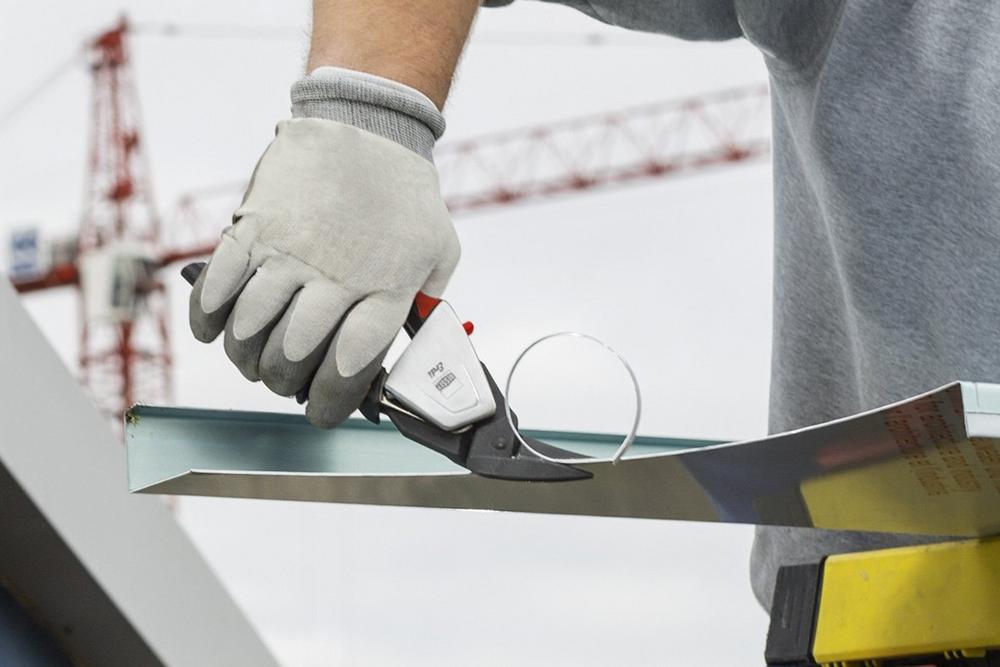Quality is our highest priority!
To constantly achieve optimum results even at high loads, the quality of raw materials and processing is of primary concern. At first glance should confirm that all forged snip parts, especially in the cutting area, are free of burrs or, that no remaining plastic protrusions are visible on the handles. Cleanly ground cutting blades also speak for a high-quality product as they leave burr-free cuts and support smooth cutting. Also, as an indication for a high-quality sheet metal snip, the manufacturer label must be clearly visible.
When choosing a snip it should be done in context of the material being cut and the frequency of use. ‘What’ is being cut is very relevant in snip selection as various qualities of steel can be selected for a snip’s construction. Within the Erdi range there are choices of standard quality steel, high quality steel, special high quality steel, HSS and HSS-TiN. As an example, the cutting of stainless steel sheet metal presents a special challenge and, the use of high-performance snips with inserted HSS blades is a good investment because they will have the greatest life expectancy with good cutting performance. In the HSS-TiN version, the cutter head is also coated with an extremely hard titanium nitride that reduces wear and tear further. This results in an even longer product life expectancy even with hard materials.
Standard tin snips are considered to be very durable as the blade and handle are forged in one piece. The force they require for cutting is determined by the ratio of blade length to grip length. Less force is required for cutting if leverage snips are used. They consist of a snip head and a handle. Both parts have hinged joints, producing additional leverage, which reduces the effort by approx. 25 percent.
The task is decisive!
As in other tool areas as well, hand tin snips should be chosen according to the application requirements. For example, straight cutting snips are made for continuous cutting through sheet metal or notching. They are used when metal sheets are severed in the middle or near the edges. Outline cutting snips are best suited for fine, narrow radius cuts near the edges of the metal sheet. Their cutting edge shape allows extremely tight radii or the cutting of figures. Shape and straight cutting snips are the general purpose hand tin snips. They are suitable for end-to-end cuts through the sheet metal, as well as for large and small contours or radii.
Each of these types of snips are available as right or left cutting models. A common misconception is that left cutting snips are suitable for left-handers. This is not the case! The designation only specifies the direction in which the radial cuts are made. The radius of left cutting snips runs from right to left. Conversely, the right cutting snips cut arcs from left to right.
Correct handling is what matters!
Not only the quality of the snips influences the result. The correct handling of the tool also matters: The metal sheet must be laid flat on the level jaw surface of the snips. Only in this way an optimum cutting pattern can be achieved by virtue of the cutting radii. It will warp if it is not flat on the jaw. Greater effort and shorter product life expectancy are the consequence of incorrect use.
For cutting, the snip jaws should be opened wide and the sheet metal pushed as far as possible into the jaws of the snips. The snips should not be completely closed when cutting: After about ¾ of the cutting length, open and close the snips again. Only in this way can a burr-free cut be made. If the snips are completely closed, small transverse tears occur with each cut at the end of the cut.
It is also important that hand tin snips are only used for cutting thin sheet metals made from soft metals and steel. They are not suitable for separating round and rectangular metal shapes such as wire. This would lead to blade breakage.
The blades must have what it takes!
If the manual force is not sufficient for cutting the sheet metal, there could be two reasons for this. Either the blades are just dull, or the metal sheet may be too thick. When using hand tin snips, it is important to note that one should only cut sheet metals up to a thickness of 1.2 to 1.9 mm. This will vary depending on the type of sheet metal, however, as well as the quality of steel.
1889 Founding of BESSEY as a bright steel drawing plant in Stuttgart. / 1936 The production of clamping tools begins. / 1944 Construction of the current parent plant in Bietigheim. / 1979 Acquisition of the Ernst DIENER shears factory, thus expanding the BESSEY product range to include ERDI shears. / 1984 Consolidation of tool and precision steel production in Bietigheim / 2004 Founding of BESSEY Präzisionsstahl GmbH. / 2005 Company renamed from BESSEY & Sohn GmbH & Co. KG to BESSEY Tool GmbH & Co. KG. / 2011 Klaus Fuchs becomes Managing Partner of the BESSEY Group. / 2019 Founding of BESSEY Präzisionsstahl Vertriebsgesellschaft mbH and the BESSEY Group celebrates its 130 year jubilee.
You can find further information on our long-established Swabian company and its products at www.bessey.de.
BESSEY Tool GmbH & Co. KG
Mühlwiesenstraße 40
74301 Bietigheim-Bissingen
Telefon: +49 (7142) 401-0
Telefax: +49 (7142) 401-333
http://www.bessey.de
Abteilungsleiterin
Telefon: +49 (7142) 401-305
Fax: +49 (7142) 401-388
E-Mail: albert@bessey.de
Marketingreferentin
Telefon: +49 (7142) 401-279
Fax: +49 (7142) 401-338
E-Mail: walter@bessey.de
